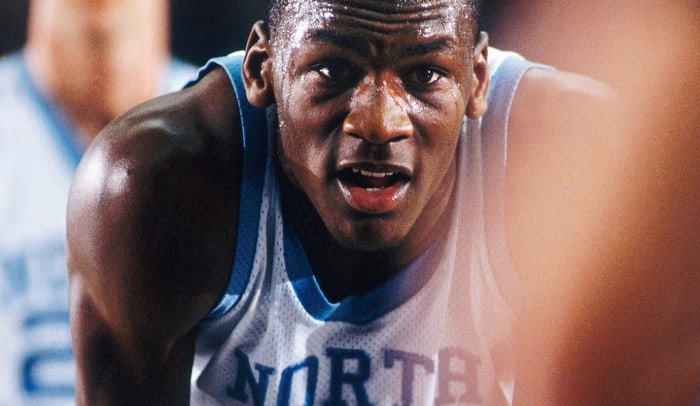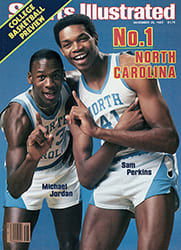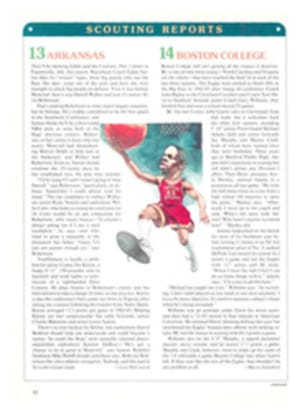A Towering Twosome
It may be because Sam played in the 1981 NCAA championship game as a freshman, and Michael, when he was a freshman, made the winning shot in the 1982 NCAA championship game, and because the two of them have already appeared in 21 NCAA tournament matches. It may be a result of both Sam and Michael being selected over the years to so many All-America teams and All-Tournament lineups and National Sports Festivals—and enough Junior World Cups and other international touring squads to qualify for diplomatic immunity. Or perhaps the explanation is simply that television has spotlighted Sam swinging those monster rubber arms down around his shoelaces and Michael wagging that tongue of his like a starving puppy so often that network execs might as well make them a weekly sitcom. Call it Chapel Hill Blues. Or, simply, Spam and Michel—as the official report on balondesto masculino (men's basketball) at the Pan American Games in Caracas, Venezuela spelled their names.
Whatever the reason, North Carolina's Sam Perkins, 22, and Michael Jordan, 20, seem to have been around college basketball forever and a day. And here come Perkins, finally a senior, and Jordan, still only a junior, one more time: Pan Am stars of summer past, probable Olympic heroes of summer future and the leaders of the Tar Heels. "They excel on all the levels," Coach Dean Smith says. "Sam and Michael are the kind of players and people you search for."
During his three seasons at UNC the 6'10", 231-pound Perkins, who plays both center and forward in Smith's multidimensional attack, has averaged 15.4 points, 8.4 rebounds and 1.8 blocked shots per game. Jordan, who is 6'6½", 201 pounds, emerged last season—only his second on the varsity—as merely the finest all-around amateur player in the world. "There is one phenomenon in college ball," says Tom Newell, a scout for the Golden State Warriors and the radio color man for the University of Virginia, "and his name is Michael Jordan."
Phenomenon meet Enigma. Perkins' on-court persona is as mundane as Jordan's is spectacular. Tales of Jordan's many and varied leaps and bounds are already prominent in Tar Heel lore, while Perkins' lefty jump hooks speak softly and fade from memory. Silent Sam disdains the dunk; his yeoman effort against Virginia's Ralph Sampson last Jan. 15, including four for four from three-point range, was the quietest 36 points on record. Perkins may have raised his fist once in excitement, though no one is sure.
Perkins is the product of a broken home. He was raised by his grandmother, Martha Perkins, a devout Jehovah's Witness, in Brooklyn's Bedford-Stuyvesant ghetto. When Perkins was a high school junior, a job placement manager named Herb Crossman became his legal guardian and moved him to Latham, N.Y., a white suburb of Albany. Perkins says it was "sad because I'd spent my whole life in Brooklyn." But then: "Homesick? I didn't have anybody to be homesick about." Because his grandmother was adamant that Sam should uphold the tenets of Jehovah and attend Kingdom Hall classes regularly, Perkins came to basketball late; he didn't play high school ball until his junior year, 1978-79. Even today, Perkins' religious upbringing seems to affect his play. "Jehovah's Witnesses teach people to be meek and mild, and I think a lot of that rubbed off on me," Perkins says. "But I can't help it if I look nonchalant. When I play it may look easy, but it isn't. I sweat."
Off the court, he doesn't sweat the game at all. Last season this made for some embarrassing Perkins quotes, such as "Who's Wayman Tisdale?" prior to Carolina's meeting with Oklahoma and "Georgia? What league are they in?" before his team's NCAA clash with the Dawgs; Perkins knew all about Georgia after the game, an 82-77 victory for the Dawgs. On both occasions Perkins' posture was taken for arrogance, but he was only being sincere. He honestly didn't know. Five years ago Perkins didn't know who Dean Smith was. He still doesn't follow basketball. Perkins washed his car rather than watch the '83 ACC tournament final between N.C. State and Virginia.
However, Perkins' relaxed, insouciant style conceals a fierce competitiveness. Jack Hartman of Kansas State, the coach of the U.S. team in the Pan American Games, held back his impressions of Perkins for a long time, and even asked Jordan whether his pal "always seemed, uh, this lazy." Jordan's reply: "That's just Sam. He'll be there." As things turned out, Jordan led the scoring in Caracas while Perkins led in rebounding and was third in scoring.
Perkins has never been tested for catatonia—"Coach Hartman told me to pep up. Gee. I saw myself as already pepped up," he says—but sometimes he appears to have missed life's wake-up call. If there is such a thing as passive aggression, Perkins invented it. Of course, when a man has fire hoses for arms—Perkins chose his Carolina number, 41, because that's his sleeve length—he can afford to drift under the backboards impersonating Perry Como. "My arms are my talent," Perkins says.
Jordan's brilliance is somehow easier to pin down. The third son of five children born to James, a General Electric plant supervisor, and Delores Jordan, a customer service rep for United Carolina Bank, Michael grew up in the coastal town of Wilmington, N.C. in a warm familial atmosphere. The family is this close: Jordan's parents have never missed one of Michael's Carolina games, home or away, including Hawaii and Greece. Roslyn, 19, graduated from Laney High School a year ahead of her class and joined Michael at Chapel Hill. Larry, a senior at UNC-Wilmington, is a year older and 11½ inches shorter than Michael, who's the giant of the family, nobody else being over six feet. Larry is usually the recipient of the booty Michael collects in his award-winning travels. "Larry always used to beat me on the backyard court," Michael says. "His vertical jump is higher than mine. He's got the dunks and some 360s and most all the same stuff I got. And he's five-seven! Larry is my inspiration." Just as he did in high school, Michael selected his number, 23, in order to "halve" his brother's 45 when they were backcourt teammates at Laney.
Jordan started out a baseball player, shifted to basketball when he grew four inches between his sophomore and junior years and remains a fan for all seasons. He can recite names, numbers and stats for every facet of jockdom, including stock-car racing, for Petty's sake. And of course his basketball knowledge goes far beyond the ACC. "I had to tell Tisdale and [Georgia's James] Banks I knew who they were," Jordan says, alluding to Perkins' gaffes. "They understood Sam meant no disrespect."
The day after Carolina's season-ending loss to Georgia last March, Jordan was spotted in Carmichael Auditorium on the UNC campus toiling away for hours on his shot. "I couldn't wait for the next game," he says. Then, after an endless summer of basketball camps, pickup scrimmages and then the Pan Am Games, Jordan returned to Chapel Hill and started playing immediately. "The freshmen were already talking trash. I had to see what they had," he says.
Smith says Jordan is the hardest worker he's ever coached. In high school Jordan hustled so, he was nicknamed The Rabbit. Rabbit, run. When he enrolled at Chapel Hill, Jordan ran the 40-yard dash in 4.6 seconds. This fall he ran a 4.3. By running and lifting weights he has substantially built up his upper body and gained 12 pounds in two years, most of it in the shoulders.
As a freshman Jordan didn't especially like playing defense. By the end of last season—after he had pulled off some miracle finishes with deflections, steals and blocks against Tulane, Maryland and Virginia—he was easily the best defensive guard in the land. "Jordan always seems to know where the ball is and where it's going," said Maryland Forward Mark Fothergill. "He roams around like a madman, playing the whole court and causing all kinds of confusion."
With his notable hunger for offensive rebounds, Jordan plays frenzied scavenger to Perkins' sloe-eyed Sluggo, all the while whipping his tongue around the premises and causing Smith considerable anguish. The coach was so appalled at the prospect of Jordan chomping the wayward tongue clean off in a collision at the rim that he went to a dentist in search of a mouthpiece that would enable Jordan to "talk on defense." No luck. Mpfshwdbl-switch-bkldsmcyx.
While Jordan is a social butterfly, Perkins is the consummate loner—"hanging out with himself as senior Forward Matt Doherty puts it—who spends much of his time in an off-campus apartment where he cooks for himself and irons as well. His intimidating size and solitude would be off-putting were it not for his easy manner and glowing cherub smile, which makes him look all of 10 years old. As a result, Perkins may be the most popular Tar Heel of all time among the young set across the state. When Perkins heard that Chris Blue, then a sixth-grader in Southern Pines, wore a UNC basketball shirt with number 41 and "PerBluekins" across the back, he sent him a picture signed "Sam PerBluekins."
Perkins has not always had such a happy life. In BedStuy, Perkins never knew his father and was somewhat estranged from his mother and three sisters, who were "pretty much on their own." Martha Perkins sent her grandson to Tilden High rather than the rougher Boys and Girls High School. The youngster's off-hours were spent going door to door spreading Jehovah's word. Still, after Perkins quit the jayvee basketball team, he was on his way to a life in the streets. "I went to school every now and then, but I wasn't interested," he says. "It was a point of no hope. I can't see myself robbing, stealing or killing anybody, but if I'd stayed out of school I'd have caused problems. I definitely would have been in a lot of trouble."
Perkins was known as Kareem on the playgrounds, and Crossman enlisted him for the local age-group team, convincing Martha that an interest in basketball wouldn't lead him away from religion. When Crossman relocated to the Albany area, Perkins helped him look for a place to live. Later it was decided Sam would be better off moving upstate as well. Now Perkins calls Latham home; for four years he has lived with a white family, the John Elaquas, who first met him when their daughter, Susan, brought her Shaker High School classmate home for dinner. Guess who stayed for the duration?
Perkins' averaged 25 points and 16 rebounds his two years at Shaker and was the object of a hot recruiting war among UCLA, Syracuse and North Carolina. But his friendship with James Worthy, formed at the 1979 Junior World Cup tournament in Brazil, may have clinched it for the Tar Heels.
Since coming to Carolina, Perkins' role has undergone some changes. As he gained confidence in his outside shot and as Worthy and then Brad Daugherty took the pressure off inside, Perkins flashed out on the floor to assume the more natural role of big forward. The sweet southpaw J hook remains his bread 'n' butter, but he's a scoring computer around the key; his career shooting percentage is 57.2 from the field and 77.5 from the line. Defensively, Perkins is so quick that Smith has had him guard everyone from 7'4" Sampson to 6'5" Vince Taylor, a former Duke guard.
Perkins says he takes to each task, big and small, with the same enthusiasm. "I try hard," he says to those who have had their doubts. "I take all the games seriously." Nevertheless, Smith has made certain Perkins will not fire up anymore enemy locker rooms. "I told Sam, this year everyone's going to be great," says Smith. "So and so? He's great. Joe Palooka? Great. Everyone's great. Everyone."
Et tu, Jordan?
Well, he's great, too. Former NBA Guard Jeff Mullins says, "The prevailing opinion always has been that Oscar Robertson and Jerry West are the two alltime best guards. But we may have to change that view because of Jordan."
Rarely has a player become so terrific so quickly. As a Laney sophomore, Jordan was a skinny 6'1" jayvee. Even after his junior year he did not rate a spot on a list of the top 500 high school players. But as a Carolina freshman he sank the 17-footer in New Orleans that beat Georgetown to win the NCAAs, and by now he's all-globe. If Perkins is Perry Como, who is Jordan? Sting?
The UNC recruiters got to Jordan early—they thought he looked like "an average ACC player"—so as to counter the attentions of, among others, South Carolina, which entertained Jordan at the governor's mansion in Columbia. As it turned out, the Carolina coaches had some convincing to do. "Growing up, I hated North Carolina," Jordan says. "I was a State fan; David Thompson was the man. My mom liked Phil Ford, but I couldn't stand him or any of them Carolina guys. I rooted for Marquette in the '77 championship game. My mom got mad." But after visiting Chapel Hill with Project Uplift, a minority student program, Jordan was hooked. "The coaches didn't know I was here. I saw this place as a student, not as a recruit," he says.
Smith felt Jordan's rookie season—13.5 points and 4.4 rebounds a game, a 53.4 field-goal percentage—was "inconsistent," especially defensively. Consequently, prominent on Jordan's "Christmas list" of items to work on in the off-season was defense. The result was that in his sophomore year Jordan won Carolina's defensive player of the game award in 13 games. He also accumulated a team-leading 110 personal fouls and fouled out of four games, all of which Carolina lost.
Scoring has never been a problem. After he made 23 of 37 shots and scored 64 points in two games against Duke last season, Blue Devil Guard Johnny Dawkins said: "Jordan goes all out. Not just physically, like he used to, but now he out-thinks you. Back door here. Lob to me here. Good defensive play there. Of all the players he's the most impressive." Then there was the time Jordan leaped completely over the head of N.C. State's Sidney Lowe. And the time Jordan made his famous "demoralizer dunk" against Georgia Tech, when he took off from the foul line, cupped the ball—"I thought I was watching Superman," said Tech Center Tim Harvey—roared by the rim after a fake front slam, then crushed home an afterthought sidewinder. And the time...
"This kid takes it to the hole as hard as anybody ever has," says Hartman. "Sometimes I felt cheated coaching him. Michael created so many incredible moves I wanted to see them all again on instant replay. But I couldn't because I was there, live."
Alas, though Jordan's shooting percentage remained static last season—53.5% along with 20 points and 5.5 rebounds per game—his outside shooting fell off. "I think the three-pointer altered my thinking," he says. "I was pressing, trying to hit too many long ones. [Jordan's three-point percentage was 44.7, fourth among the five Carolina guards.] Plus, my arc got higher and higher. I think the winning shot in '82 went to my head or something. I must have watched it on film 30 times. That thing was a rainbow. Wow."
Wow, yourself. All summer Jordan worked on his shooting and ball handling—Smith says, "It would be fun to see Michael be a point guard in the pros"—and on his jab-step fake, a move so quick it fools referees into whistling him for traveling. More late-breaking news: Gaps have been discovered in Jordan's knees, which means he hasn't stopped growing.
Before Perkins and Jordan graduate—and both are on schedule, credit-wise, Perkins in communications (he has publicly campaigned for Al McGuire's job), Jordan in geography—the two may concoct some more Tar Heel history. Perkins needs only to maintain his average annual numbers to finish as the school's best rebounder, surpassing the likes of Billy Cunningham and Mitch Kupchak, and second-best scorer, trailing Phil Ford. Of course, if Jordan keeps his scoring average, he would pass Perkins and Ford to be No. 1.
All of which pales in comparison to the true measurement of Carolina success: getting one's name on a sandwich at Chapel Hill's Four Corners restaurant. Recently, The Jordan—crab salad on pita with lettuce and tomato—took its place on the menu alongside the Sam-Wich, SMITHsonian, Big McAdoo, Fabulous Phil and Miller Filler. The Jordan started out to be—what else?—tongue, but that was too expensive. So now The Jordan is $3.75, and the Sam-Wich is $4.15. The Sam-Wich is grilled pastrami and ham with special sauce, hot mustard, sautéed onions, sprouts and melted provolone. One day Perkins came in to taste this monstrosity. A half hour later the honoree was still picking through the debris. "I don't know about these sprouts," Perkins said. "What are these sprouts?"
They're great, Sam. Remember? Everything's great.
TWO
PHOTOS
Perkins (left) and Jordan are the first All-Americas on the same team since Indiana's Kent Benson and Scott May in 1975-76.
PHOTO
Before putting a hand in the hoop against Georgia, Perkins put a foot in his mouth.
PHOTO
Jordan's soaring scoring last summer led the red, white and blue to the Pan Am gold.
TWO PHOTOS
Perkins presses in a quiet way; Jordan excels at good coverage.
PHOTO
Sam and Michael are a class act in any class they enter.


